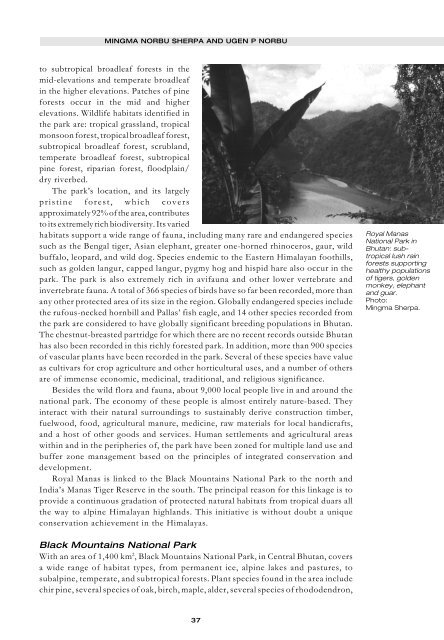Parks - IUCN
Parks - IUCN
Parks - IUCN
Create successful ePaper yourself
Turn your PDF publications into a flip-book with our unique Google optimized e-Paper software.
MINGMA NORBU SHERPA AND UGEN P NORBU<br />
to subtropical broadleaf forests in the<br />
mid-elevations and temperate broadleaf<br />
in the higher elevations. Patches of pine<br />
forests occur in the mid and higher<br />
elevations. Wildlife habitats identified in<br />
the park are: tropical grassland, tropical<br />
monsoon forest, tropical broadleaf forest,<br />
subtropical broadleaf forest, scrubland,<br />
temperate broadleaf forest, subtropical<br />
pine forest, riparian forest, floodplain/<br />
dry riverbed.<br />
The park’s location, and its largely<br />
pristine forest, which covers<br />
approximately 92% of the area, contributes<br />
to its extremely rich biodiversity. Its varied<br />
habitats support a wide range of fauna, including many rare and endangered species<br />
such as the Bengal tiger, Asian elephant, greater one-horned rhinoceros, gaur, wild<br />
buffalo, leopard, and wild dog. Species endemic to the Eastern Himalayan foothills,<br />
such as golden langur, capped langur, pygmy hog and hispid hare also occur in the<br />
park. The park is also extremely rich in avifauna and other lower vertebrate and<br />
invertebrate fauna. A total of 366 species of birds have so far been recorded, more than<br />
any other protected area of its size in the region. Globally endangered species include<br />
the rufous-necked hornbill and Pallas’ fish eagle, and 14 other species recorded from<br />
the park are considered to have globally significant breeding populations in Bhutan.<br />
The chestnut-breasted partridge for which there are no recent records outside Bhutan<br />
has also been recorded in this richly forested park. In addition, more than 900 species<br />
of vascular plants have been recorded in the park. Several of these species have value<br />
as cultivars for crop agriculture and other horticultural uses, and a number of others<br />
are of immense economic, medicinal, traditional, and religious significance.<br />
Besides the wild flora and fauna, about 9,000 local people live in and around the<br />
national park. The economy of these people is almost entirely nature-based. They<br />
interact with their natural surroundings to sustainably derive construction timber,<br />
fuelwood, food, agricultural manure, medicine, raw materials for local handicrafts,<br />
and a host of other goods and services. Human settlements and agricultural areas<br />
within and in the peripheries of, the park have been zoned for multiple land use and<br />
buffer zone management based on the principles of integrated conservation and<br />
development.<br />
Royal Manas is linked to the Black Mountains National Park to the north and<br />
India’s Manas Tiger Reserve in the south. The principal reason for this linkage is to<br />
provide a continuous gradation of protected natural habitats from tropical duars all<br />
the way to alpine Himalayan highlands. This initiative is without doubt a unique<br />
conservation achievement in the Himalayas.<br />
Black Mountains National Park<br />
With an area of 1,400 km 2 , Black Mountains National Park, in Central Bhutan, covers<br />
a wide range of habitat types, from permanent ice, alpine lakes and pastures, to<br />
subalpine, temperate, and subtropical forests. Plant species found in the area include<br />
chir pine, several species of oak, birch, maple, alder, several species of rhododendron,<br />
37<br />
Royal Manas<br />
National Park in<br />
Bhutan: subtropical<br />
lush rain<br />
forests supporting<br />
healthy populations<br />
of tigers, golden<br />
monkey, elephant<br />
and guar.<br />
Photo:<br />
Mingma Sherpa.

















